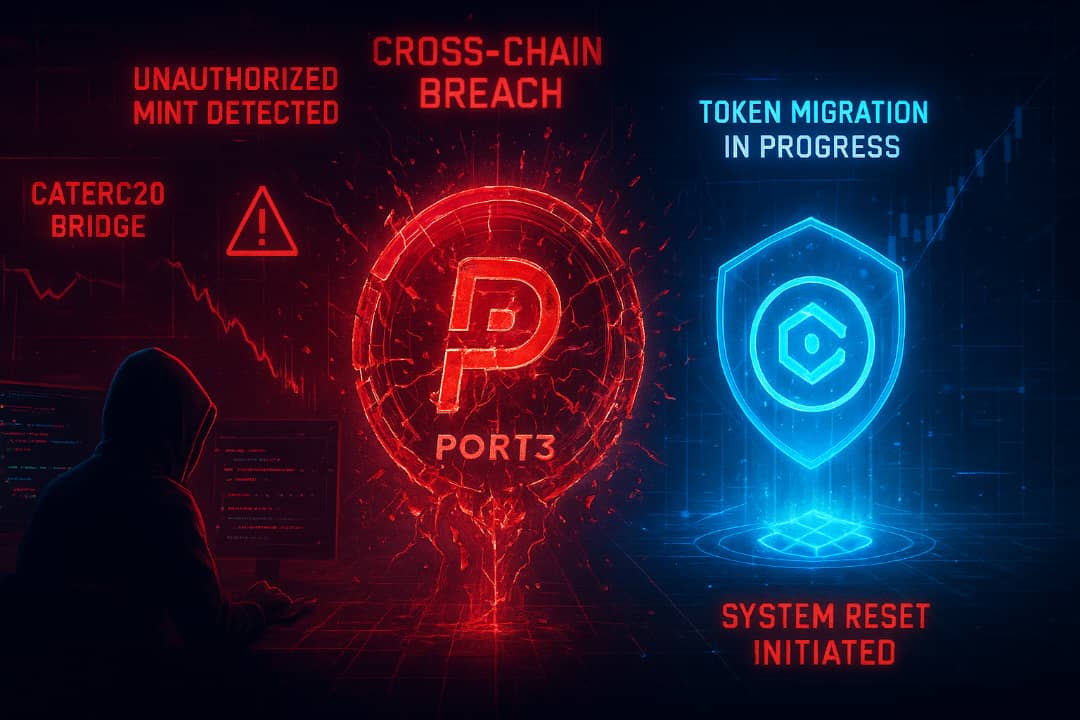
Port3 Exploit: A Crisis Unfolded
Today, Port3 Network faced a critical exploit that exposed vulnerabilities in the Nexa Network’s CATERC20 cross-chain token standard. This breach allowed unauthorized minting of tokens, triggering a price collapse and a full-scale token migration to restore stability. Here’s the detailed breakdown of the incident and recovery plan.
What Went Wrong with CATERC20?
The CATERC20 token standard, integrated by Port3 to enable cross-chain messaging and multi-chain functionality, carried a boundary-condition validation flaw. When ownership of the Port3 token contract was renounced—a measure aimed at increasing decentralization—the contract’s validation logic returned a value of 0. This critical flaw caused the ownership verification process to fail, treating unauthorized addresses as “valid.”
Despite undergoing an audit, the flaw was not detected in the CATERC20 security review. Unfortunately, when ownership was renounced, the token contract entered a configuration that left it vulnerable to exploitation.
How the Exploit Unfolded
On November 23, 2025, the attacker discovered the authorization-verification flaw and acted quickly. By utilizing the RegisterChains operation, the attacker registered his address as an authorized BridgeIn operator. Following this, the attacker launched a fake token on Arbitrum One and initiated cross-chain transactions that bypassed validation.
With the broken verification logic granting the attacker legitimacy, a staggering 1 billion PORT3 tokens were minted in a single transaction. These tokens were immediately sold across decentralized exchanges (DEXs), leading to a price collapse from $0.03 to $0.0063 within minutes.
The attack was then repeated using additional addresses, further draining liquidity and collapsing the token’s market value. Port3 responded by halting operations on centralized exchanges and suspending withdrawals to prevent further damage.
Port3’s Recovery Plan: Turning the Crisis Around
Port3 has announced a comprehensive recovery strategy that prioritizes user funds and long-term ecosystem stability. The following measures are now in progress:
- 1:1 Token Migration: A snapshot was taken at 20:56 UTC, immediately after the attack. All users who held $PORT3 tokens before that time will receive a full 1:1 token replacement. This will apply to on-chain wallets and centralized exchange (CEX) balances.
- On-Chain Multi-Send Distribution: New tokens will be distributed directly to affected holders through multi-send transactions of 200–500 tokens per transfer.
- BNB Chain Migration: Moving forward, $PORT3 will exist exclusively on the BNB Chain, improving security and simplifying operations by eliminating multi-chain vulnerabilities.
- Burning Excess Tokens: To neutralize the unauthorized minting of 1 billion tokens, Port3 will burn 162,750,000 team tokens. This measure restores the supply balance and prevents inflation.
The Port3 team has assured its users that no legitimate funds will be lost and encourages patience as recovery efforts continue. Key updates and CEX coordination reviews are underway to resume trading safely.
Lessons Learned: Avoiding Future Threats
This exploit reveals the dangers of cross-chain vulnerabilities and the critical importance of rigorous testing and validation in smart contract design. Port3 has pledged to improve security measures and strengthen its ecosystem for a more resilient future.
Recommended Tools for Crypto Security
For cryptocurrency investors and developers, ensuring asset security is vital. Tools like Ledger Nano X, a reliable hardware wallet, can provide enhanced protection for your digital assets. Check out the Ledger Nano X here for safer crypto storage: ledger.com.
Stay informed with updates from Port3 and follow our website for the latest cryptocurrency news and insights.



